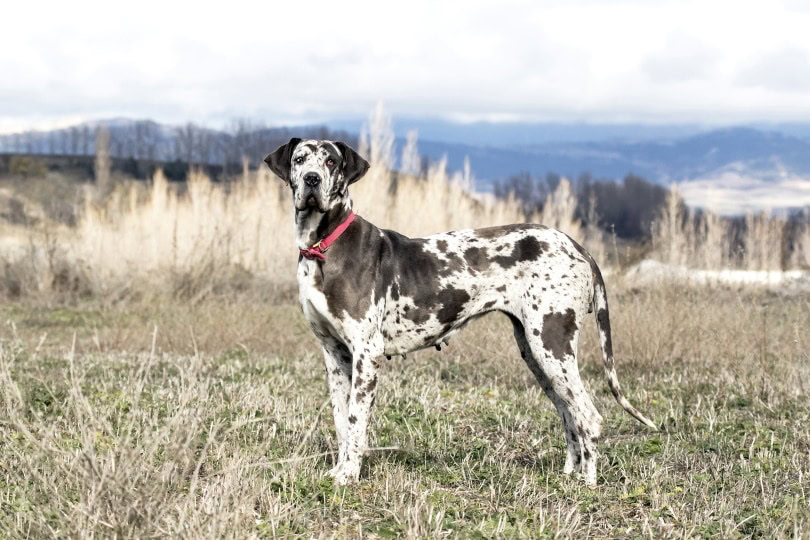VET APPROVED

The information is current and up-to-date in accordance with the latest veterinarian research.
Learn more »Click to Skip Ahead
As any dog owner will tell you, having a dog as a companion is one of the greatest joys in life.
As pet parents, you already know that your dog fills your life with love, companionship, and smiles whenever he’s around. So, of course, you do everything you can to return that love by keeping your pup healthy and happy.
Humans very rarely outlive their dogs. You know that small dogs usually live longer than large dogs, but do you know the average lifespan of smaller and larger dogs? Do you know the facts? If not, we’ll go into a few of those facts here, as well as how to take care of your canine pal, so they can be your loyal companion for the longest amount of time possible. The average lifespan of a dog is 11–12 years.

How Long Is the Average Lifespan of Dogs?
The average lifespan of a dog is said to be between 11 and 12 years. While it is largely influenced by body size, in general, only 20% of dogs live over their 14th birthday, with fewer than 10% making it to their 15th birthday.
So, not all dogs live to their full lifetime potential. There are factors to consider, such as the breed, diet, habits, and lifestyle of the dog in question. The health and genetic predispositions of the dog also must be considered.
Unfortunately, even if you could nail down the average lifespan of dogs to a number, it’s not helpful for every dog breed. This is because breeds, sizes, the body structures of the different breeds, and related health issues must be considered as well.
Plus, the dog’s upbringing and the type of environment and care the dog is subjected to must be considered, as these things significantly impact how long the dog will live.
If you want to try and gauge how long your furry friend will live, you need to take a few things into consideration. We’ll go into a few of those things in the following sections.

Exactly How Long Is a Dog Year?
When it comes to how long a dog year is, many pet owners get easily confused. Dog age calculators and charts will tell you that one dog year equals seven human years.
So, if your dog is a year old, he’s actually seven years old in human years. While this is a fun thing to sit and try to figure out, it’s not entirely accurate because a dog’s development is much faster during the first year or two of life, depending on their size and breed. Development slows down once dogs reach adulthood, so it’s quite clear that this isn’t an accurate way to determine how long your pup should live.
What Factors Influence How Long a Dog Lives?
Of course, you already know that your dog’s breed and health will help determine how long he will live. However, you need to factor in your dog’s lifestyle, genetics, and diet when it comes to their health as well.
To understand how you can help your pup live a long, happy life, we need to explore these aspects just a little deeper.
1. Dietary Factors
Just as with humans, what you feed your dog can have a direct bearing on how long they will live. The food you feed your pup from the time you bring them home will greatly influence their health and lifespan.
If you’re unsure what the best food for your dog is, consult with your vet. After examining your pet, they can help you determine the healthiest dog food to keep them healthy, fit, and trim.
Sticking to a controlled and healthy diet has been proven to help many dogs live into their prime and beyond. Not only does healthy food increase their lifespan, but it also improves the dog’s quality of life by decreasing their chances of developing osteoarthritis as they age.
The wrong food, or even too much of it, can lead to your furry friend becoming overweight or obese. Studies have linked obesity in dogs to certain cancers, so feeding your dog healthy food as well as not overfeeding them will help to prevent this disease from happening to you and your pet. Obesity has also been linked to cardiovascular problems, diabetes, and several other health problems in canines.
Feeding your pet a restricted diet will help them live the long, healthy life you want them to live. Feeding complete and balanced, fresh, less processed diets that are rich in natural ingredients and contain antioxidants can also help increase a dog’s health and longevity.
2. Dog Breed
Another factor that must be considered when trying to figure out your dog’s average lifespan is their breed. Their breed will have a dramatic effect on how long they are expected to live.
Many large studies have been done on the different dog breeds, and the data was analyzed carefully. As a result, it was determined that the parental breed lines of your pup has clear implications when it comes to life expectancy.
For example, the Afghan Hound has a life expectancy of 12 years, while the Miniature Poodle has a life expectancy of 14 years.
However, the breed of your dog isn’t the only thing you need to consider. You need to consider the size of your dog as well.

3. Dog Size
Studies have shown that small dogs have a greater life expectancy than their larger counterparts do. For example, the life expectancy for an Irish Wolfhound, which weighs around 120 pounds, is approximately seven years. On the other hand, a Jack Russell Terrier, which tops out at about 15 pounds, has an average life expectancy of 12 to 14 years.
The difference in the size and weight of the dog, coupled with their diet, has a huge impact on how long they will live.
4. Purebreds vs Mixed Breeds
It is said that mixed breeds have a longer life expectancy than purebreds do. This is because crossbred and inbred dogs tend to have the risk of developing diseases and conditions that either of their parents could have passed down or that could have been passed down through the generations.
It’s essential to check the family history when purchasing a puppy from a breeder. The lower the percentage of the coefficient of inbreeding (COI), the less inbreeding there will be, which hopefully means fewer possible health problems and a longer life expectancy for your new canine pal.
Luckily, modern science allows breeders to check parental lines for genetic conditions. Do your research and be sure you ask the breeder for the results of the recommended tests for each breed.

5. Neutering/Spaying
Neutering or spaying your new puppy can have a positive impact on the life expectancy of that dog. In addition, some studies have shown that having this procedure done for your pup can reduce the chance of your pet developing certain cancers.
Neutering or spaying is said to reduce the risk of cancers that target dogs. It’s also the best way not to end up with a litter of puppies when all you wanted was one single pet.
Just make sure that you do it at the right time since neutering or spaying your puppy too soon can also harm their health and longevity. Speak to your vet to make sure they are following the updated recommendations for the best time to perform the procedure according to your dog’s breed.
6. Your Dog’s Healthcare
The last factor that weighs heavily on your pup’s life expectancy is the dog’s lifestyle and how well you care for them.
We’ve already determined that a healthy diet is essential, but there are other factors to consider. How well you care for your pet is vital, meaning you need to provide regular exercise, grooming, and checkups with the vet, so that your pet can continue to lead his best life into his golden years.
Vaccinations are essential, as well as worming, tick and flea treatments, and trips to the groomer for teeth cleaning and baths.


Average Lifespans of Common Dog Breeds
Small Dogs

| Pomeranian | 12–16 years |
| Chihuahua | 14–16 years |
| Maltese | 12–15 years |
| Miniature Poodle | 10–18 years |
| Dachshund | 12–16 years |
Medium Dogs

| Beagle | 10–15 years |
| Border Collie | 12–15 years |
| Bassett Hound | 12–13 years |
| American Fox Hound | 11–13 years |
| Boxer | 10–12 years |
Large Dogs

| St. Bernard | 8–10 years |
| Great Dane | 7–10 years |
| Rottweiler | 9–10 years |
| Doberman Pinscher | 10–12 years |
| Tibetan Mastiff | 10–12 years |

Final Thoughts
This concludes our guide on how long dogs live. While the average life expectancy of dogs as a species is between 11 to 12 years, it’s essential to consider all the factors that go into your dog’s life expectancy and quality. It’s important to do what you can to keep them as healthy as they can be.
There really is no set year that your pup is going to pass away, just as there’s no set year that you as his owner will go to meet your heavenly maker. So, the best we can do as pet parents is to follow the tips above, take great care of our furry friends, and hope they live long, healthy, and happy lives.
Featured Image Credit: ForeverNaturalPhotography, Shutterstock












